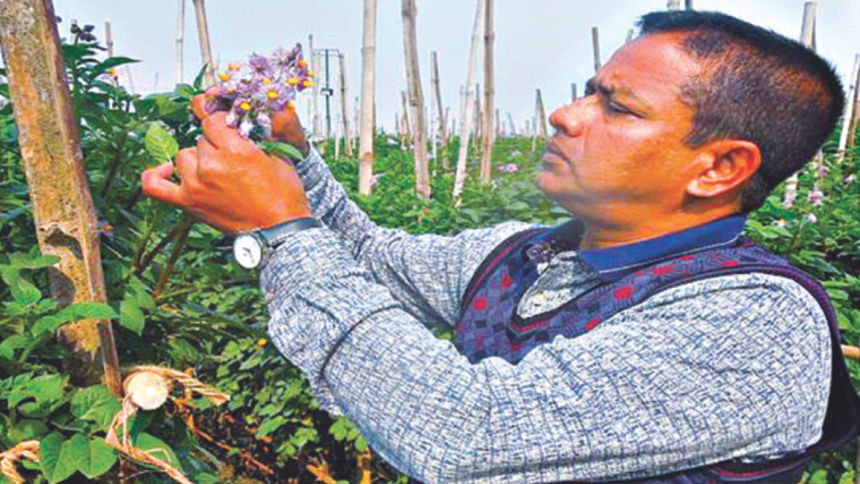Seeds of Change

The potato is a versatile plant. It's easy to grow potatoes from “seed potatoes”, which are either small potato tubers or larger ones cut into pieces. Even in less-than-ideal conditions these tubers will readily sprout to grow into a new crop. This method is the most common way to grow potatoes. But it's not the only way.
In Nilphamari, the production of potatoes from “true seed” is being trialled. This method involves allowing potato plants to mature until they produce male and female flowers. With cross-pollination the plants then bear a greenish fruit about the size of a small tomato. Like most parts of the potato plant, the fruit are toxic; but inside they are full of seeds. These “true seeds” can later be planted to establish another potato crop.
“It's surprising to know that true potato seeds are tiny,” says Ataur Rahman, the assistant director of the Domar Foundation farm where the Bangladesh Agriculture Development Corporation sponsored trial is underway. “Each one is only about two millimetres long, not dissimilar to the brinjal or chilli seeds that we more often see.”
The main advantage of producing true seeds is easy storage. Tubers take up a lot of space, are bulky to transport and require cold storage to protect against rotting. Tubers also attract rodents and other pests such that they can be damaged before the sowing season has arrived. By contrast, true potato seeds can be stored securely and simply, in an airtight glass jar.

There are other advantages too. As potatoes grown from tubers are effectively clones of the original, there is less genetic diversity. Their relative homogeneity makes the crop more disease-prone, with the extensive use of chemical treatments required if disease occurs. The tuber propagation method also precludes the development of new potato varieties.
“We've produced potatoes from seed on a small scale over the last few years,” explains Ataur.
“This year we launched a larger-scale trial. Interestingly, only 600 grams of seeds are needed to sow an acre and produce a 4.5 tonne yield. To achieve 3.5 tonnes of potatoes per acre using tubers, around 720 kilograms of potato tubers would be required at the outset. Thus the true seed method is significantly more practical at the planting stage, and also produces a better harvest.”
The farm is using two hybrid potato varieties developed by the Bangladesh Agriculture Research Institute with good seed production in mind.
To visit the farm around two months after the potato seeds were planted is to see rows of eye-catching white male blossoms mixed among light blue and cream female ones, with the plot having been bathed in high-voltage sodium light for a few hours per day to encourage flowering.
“It's a technical procedure to plant them,” says the farm's senior additional director Rezaul Karim. “First male and female seeds need to be sorted. Then they are sown in the proportion of one male to four female plants. We have trained staff to assist pollination by bringing pollen grains from male flowers in contact with the stigma of each female flower. After that it takes around three weeks for the fruit to reach jujube-like size.”

Once the fruits are harvested they are soaked for a week to loosen the seeds from the flesh. To collect the seeds is then quite straightforward.
Local farmers are already lining up to get their hands on this year's seeds.
“Many of us are eagerly awaiting the potato seeds,” says one farmer, Golam Mostafa from Angarpara village in Nilphamari sadar upazila. “In previous years we have also used the seeds in this area and we found it more profitable than growing potatoes in the usual way.”

 For all latest news, follow The Daily Star's Google News channel.
For all latest news, follow The Daily Star's Google News channel. 




Comments